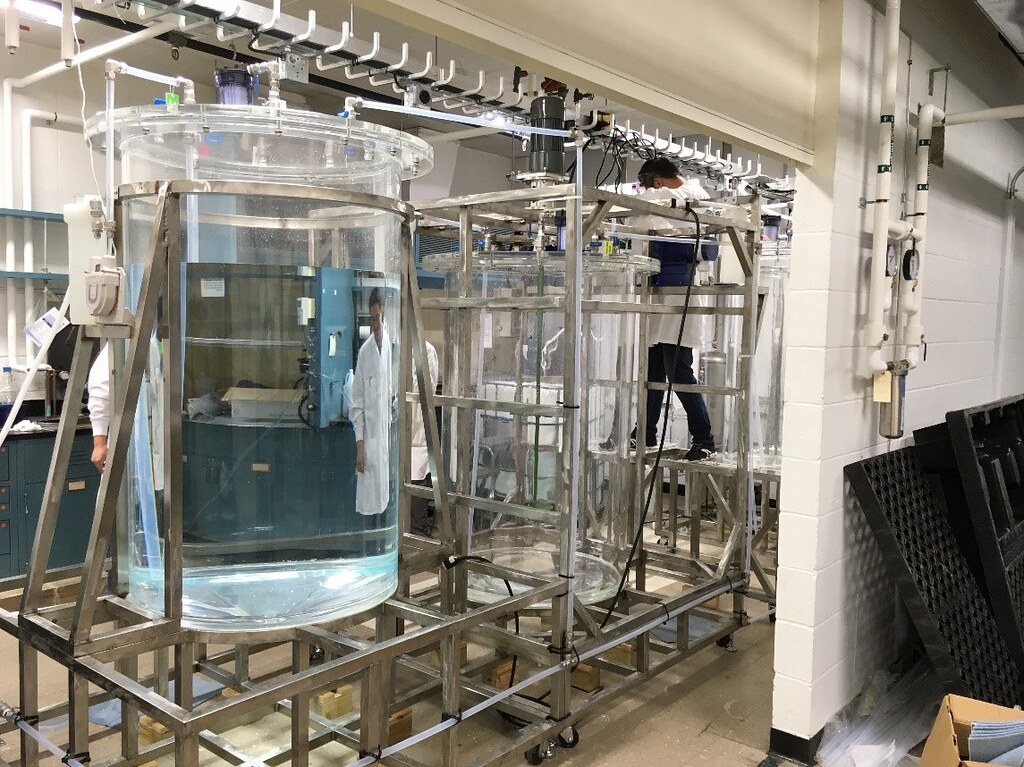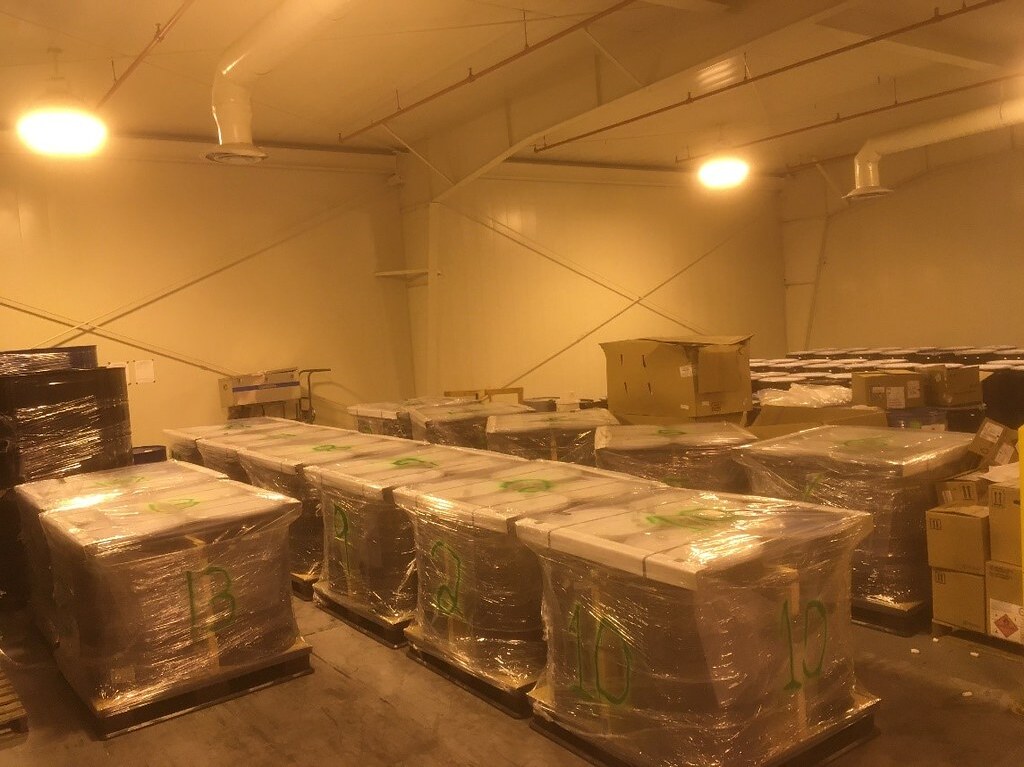- Home
-
Research Groups
Division Groups
- Artificial Photosynthesis
- Catalysis: Reactivity & Structure
- Electrochemical Energy Storage
- Electron- and Photo-Induced Processes for Molecular Energy Conversion
- Neutrino and Nuclear Chemistry
- Surface Electrochemistry and Electrocatalysis
Associated Groups
- Catalysis for Alternative Fuels Production
- Nanostructured Interfaces for Catalysis
- Structure and Dynamics of Applied Nanomaterials
- People
- Operations
- News
- Events

Neutrino and Nuclear Chemistry
Liquid Scintillator Production Facility (LSPF)
Scaling from bench-top to “neutrino” project scale requires expertise from chemistry, physics, and engineer. The NNC group has professional experts from varied scientific fields to advance the design, construction, and installation for scale-up production and purification of scintillator materials. The group also develops detector-medium deployment schemes for varied experiments. The BNL-LSPF is the only ton-scale production facility for liquid scintillator detector in US academic institutes.
Current scintillator production sites for PROSPECT and LZ; and potential site for AIT/NEO.
Pilot-Scale Short-Path Thin-film Vacuum Distillation System
This custom-made vacuum distillation system manufactured by VTA GmbH was acquired specifically to purify the more than 18 tons of linear alkyl benzene (LAB) needed for producing liquid scintillator for the LZ dark matter experiment. The system works on the same principle as the laboratory scale vacuum distillation systems described in equipment section and has similar mechanical, vacuum, and temperature control systems. However, every component of this system has been upgraded in capacity and assembled with greater precision, to enable and maintain fine process control while scaling up the throughput.
The system can process up to 40 kg of liquid per hour. Liquid is fed through and out of the system by special gear pumps that are capable to maintain low vacuum inside the system while pumping. The vacuum system consists of dual roughing pumps coupled with an oil diffusion pump, which enables the system operating pressure to be as low as 10-4 mBar, making it possible to achieve a high degree of distillation separation at significantly lower temperatures compared to STP. To help collect the distilled vapors as well as collect any volatile components, the system has three low temperature condensation stations controlled by independent chillers.
The system has been used to “purify” LAB by separating coloring impurities, as well as to distill out excess water from liquid scintillator in order to improve its stability and optical properties. Future uses for this system will include further purification campaigns for the large-scale production of liquid scintillator precursor chemicals.

Activated Aluminum Oxide (Alumina) Column Filtering System
Activated aluminum oxide (Alumina) is a highly porous material and is used as the exchange medium in our solvent filtration column system. Alumina filters out both organic and inorganic impurities through the process of adsorption, where impurity molecules get trapped due to the large surface area in the many tunnel like pores in the material.
The filtration system consists of six columns filled with ~1mm diameter alumina beads. The solvent to be filtered is first filled into a reservoir or “keg”. The keg is then pressurized to ~10 – 15 psi using an inert gas such as nitrogen or argon, which forces the liquid through a system of one-way valves (to prevent back flow) into the six alumina filled columns. As the liquid flows between and through the alumina beads the impurity molecules are trapped on the activated surfaces. The filtered liquid then passes through a final ~0.2 – 1 μm pore size PTFE membrane to filter out any particulate matter that may be too large to get adsorbed by the alumina. The liquid is then collected in 200L drums with special polyethylene liners.
The alumina filtration system is faster than the vacuum distillation system with a processing rate of 30 kg/hour and can achieve an even greater purification. However, the purification level depends on the “life cycle” of alumina since the pellets have a finite capacity of capturing impurities, which goes on decreasing as the pellets are saturated with impurities.

1000L Sequential-Mixing Reactor System
The large mixing system is a custom-made process reactor array that, as its name suggests, is used for the large-scale production of liquid scintillator. During a single production run of the large mixing system, the scintillator precursor material components produced using the varied process reactor tanks (seen in the photo) are combined and diluted with the appropriate amount of scintillator solvent, in sequence, in the final mixing tank to produce 1000 liters of liquid scintillator per batch.
The large mixing system was custom manufactured by NAKANO International Co., Ltd, in Taiwan and consists of six purpose built acrylic vessels. The liquids passing from one tank to another are all filtered using ~0.2 – 1 μm porosity PTFE membrane filters. Scintillator solvent form the storage vessel along with the other component liquids is pumped into the central mixing vessel by using either vacuum pressure or special flow-controlled pumps to ensure correct mass proportions. Once the components are all thoroughly mixed in by the stirrer in the central vessel, the scintillator is then pumped into the final holding tank for QA inspection and to allow for liquid to settle. The settling time helps with the completion of any chemical reactions as well as lets any impurities to settle to the bottom of the tank from which they can be removed using a drain valve. Finally, the scintillator can be pumped out of the holding tank and into 200L drums through a final PTFE membrane filter.

Building 855 Chemical Storage Facility
The NNC group has a special agreement with the Waste Management Division at BNL, who allow us the use of their temperature-controlled warehouse building (Building 855). The building is specifically designed and built to accommodate hazardous liquid chemicals and has special spill and other hazard containment systems and features. The building provides a safe and convenient storage of large amounts of liquid scintillator.





